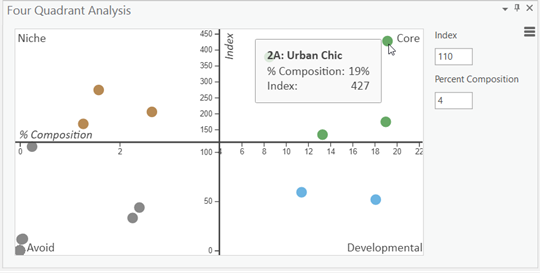Disponible con licencia de Business Analyst.
Target Marketing helps you to understand the characteristics of your customers and markets, allowing you to determine where more of these types of customers are located. Target Marketing tools can be used to discover untapped markets and develop strategies that will find customers for your products and services.
Segmentation profiles
Segmentation profiles are the foundation of Business Analyst Target Marketing and show how your customers are distributed across a market in relation to socioeconomic groupings. Target Marketing requires two profiles, which are compared to each other to categorize your customers.
Customer profile
A customer segmentation profile is a distribution of segments with counts and percentages of your customers. Each point is assigned to a standard geography, which contains households, population counts, or both for each segment, depending on the segmentation system you are using. The segment count for each point is based on the number of segments and the count for the point. If there is a single segment, the count will be one for each point. However, if there are multiple segments, the count for each segment will be proportionally calculated.
Customer segmentation profiles are created with the Generate Customer Segmentation Profile tool. This tool can be accessed from the Target Marketing wizard or the Target Marketing toolset.
Customer profiles are stored as items in the Target Marketing subfolder of the Business Analyst node in the Catalog pane.
Market area profile
A market area segmentation profile is a distribution of segments with counts and percentages of households or adults that reside in the input market. Market area segmentation profiles are created with the Generate Market Area Segmentation Profile tool. This tool can be accessed from the Target Marketing wizard or the Target Marketing toolset.
Typically, a customer segmentation profile is compared to a market area segmentation profile to analyze how well you are attracting from each segment. This is done by comparing the percentage of your customers that fall in each segment to create indexes. The index for each segment measures the percentage of customers versus the percentage of people in the market area. An index above 100 means that you are attracting customers from that segment at a higher rate than they occur in the market area.
For example, if 10 percent of customers in the target profile and 5 percent of households from the base profile are assigned to segment X, the index is 200 (10 percent / 5 percent * 100). This indicates that you are attracting customers from that segment at twice the rate at which they occur in the market area. In most cases, the base profile is the geographic area from which you draw close to 100 percent of your customers.
Four-quadrant analysis
The Four Quadrant Analysis pane displays segments as points on a four-quadrant chart, where the y-axis value represents the index of each segment and the x-axis value represents the percent composition of the segment. You can manually update the Index and Percent Composition values from the text box or drag the x- or y-axis, adjusting which segments fall into each of the four quadrants. Using this chart, you can identify Core, Developmental, Avoid, and Niche customers.

Four-quadrant analysis, using the default index (110) and percent composition (4 percent), places segments into one of the four quadrants:
- Core customers—Segments that make up 4 percent or more of your customers and index at 110 or greater.
- Developmental customers—Segments that make up 4 percent or more of your customers but have index values that are less than 110.
- Niche—Segments that make up less than 4 percent of your customers and have an index value of 110 or greater.
- Avoid—Segments that make up less than 4 percent of your customers and have index values of less than 110.
Targets
Target Marketing is made up of several components that work together to tell the story of your customers.
Targets are collections of one or more segments that are grouped together based on similar characteristics in your customer base. Sets of targets are consolidated into target groups.
By default, Core, Developmental, Niche, and Avoid targets are included in the target group created by four-quadrant analysis. Additional targets can be added to a target group.
Segments containing a high percentage of your customer base and above-average indexes are your Core target. Segments that make up your Core target contain a larger percentage of your customer base than that of the market area. These segments represent loyalty and good opportunity.
Segments that make up a significant percentage of your customers but do not have an above-average index are your Developmental target. These segments are important because they represent a significant portion of your customers but are consuming your product at a lower rate than occurs in the market area. This is an indication of significant opportunity.
Segments that do not make up a significant percentage of your customers but do have an above-average index are your Niche target. Assignment to this target indicates that you are attracting from this small pool of households very well. Niche segments represent opportunities when exploring new market areas for expansion and growth.
Segments that do not make up a significant percentage of your customers and have below-average indexes are your Avoid target. Segments in this target represent consumers that do not consume your product.
Target groups
Target groups are collections of targets that are grouped together for further analysis. The most efficient method of creating target groups is to identify target segments based on comparison of your customer and market area segmentation profiles. Once these two profiles are created, you can use the wizard to define Core, Developmental, and Niche targets that make up your target group. These can be mapped individually as targets or collectively as a target group.